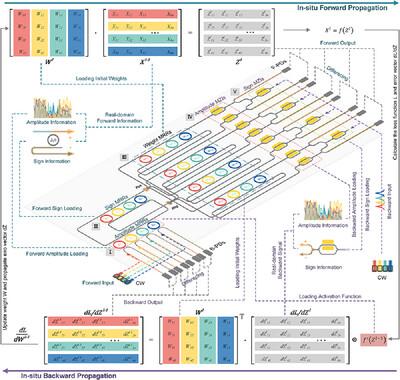用于可扩展和鲁棒光子计算的原位训练微环神经网络
IF 10
1区 物理与天体物理
Q1 OPTICS
引用次数: 0
摘要
光子计算提供高速、大带宽和超低功耗,使其成为传统电子处理器的一个有前途的替代品,特别是对于矩阵向量乘法(MVM)和卷积任务。在光子结构中,基于微环谐振器(MRR)的光神经网络(ONNs)由于其紧凑的占地面积和波分复用而具有吸引力。然而,mrr对环境干扰和串扰高度敏感,限制了计算精度。虽然原位训练已经成为通过在计算过程中调整权重来提高系统性能的有效方法,但它需要实值双向处理来支持反向传播,这对于基于非相干MRR的系统来说是一个重大挑战。本文演示了一种基于原位训练MRR的ONN,该ONN通过实值双向光学计算克服了这些限制。通过集成多波长复用和片上正向和反向传播,该架构可以通过光反向传播更新物理参数,而不依赖于查找表。实验验证与数字计算结果完全匹配,在分类任务中,该方法的准确率比传统MRR权重库提高了13.3%,在长时间运行下仍能保持精度。系统分析证实了该架构对热光串扰和环境变化的鲁棒性。这项工作为下一代人工智能硬件的可扩展、扰动弹性光子计算建立了一条途径。本文章由计算机程序翻译,如有差异,请以英文原文为准。

In‐Situ Trained Microring‐Based Neural Networks for Scalable and Robust Photonic Computing
Photonic computing offers high speed, large bandwidth, and ultra‐low power consumption, making it a promising alternative to traditional electronic processors, especially for matrix‐vector multiplication (MVM) and convolution tasks. Among photonic architectures, microring resonator (MRR)‐based optical neural networks (ONNs) are attractive due to their compact footprint and wavelength‐division multiplexing. However, MRRs are highly sensitive to environmental disturbances and crosstalk, limiting computational accuracy. While in‐situ training has emerged as an effective method to enhance system performance by adapting weights during computation, it requires real‐valued bidirectional processing to support backpropagation—a significant challenge for noncoherent MRR‐based systems. Here, an in‐situ trained MRR‐based ONN that overcomes these limitations through real‐valued bidirectional optical computing is demonstrated. By integrating multiwavelength multiplexing with on‐chip forward and backward propagation, this architecture enables physical parameter updates via optical backpropagation without lookup table dependency. Experimental validation perfectly matches digital computing results and shows a 13.3% accuracy improvement over conventional MRR weight banks in classification tasks, with sustained precision under prolonged operation. Systematic analysis confirms the architecture's robustness against thermo‐optic crosstalk and environmental variations. This work establishes a pathway toward scalable, disturbance‐resilient photonic computing for next‐generation artificial intelligence hardware.
求助全文
通过发布文献求助,成功后即可免费获取论文全文。
去求助
来源期刊
CiteScore
14.20
自引率
5.50%
发文量
314
审稿时长
2 months
期刊介绍:
Laser & Photonics Reviews is a reputable journal that publishes high-quality Reviews, original Research Articles, and Perspectives in the field of photonics and optics. It covers both theoretical and experimental aspects, including recent groundbreaking research, specific advancements, and innovative applications.
As evidence of its impact and recognition, Laser & Photonics Reviews boasts a remarkable 2022 Impact Factor of 11.0, according to the Journal Citation Reports from Clarivate Analytics (2023). Moreover, it holds impressive rankings in the InCites Journal Citation Reports: in 2021, it was ranked 6th out of 101 in the field of Optics, 15th out of 161 in Applied Physics, and 12th out of 69 in Condensed Matter Physics.
The journal uses the ISSN numbers 1863-8880 for print and 1863-8899 for online publications.

 求助内容:
求助内容: 应助结果提醒方式:
应助结果提醒方式:


